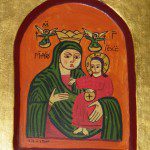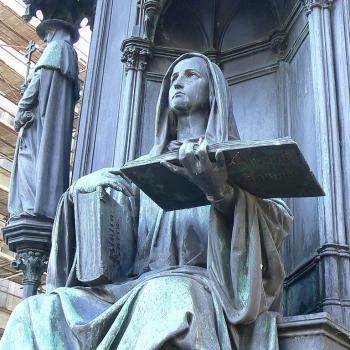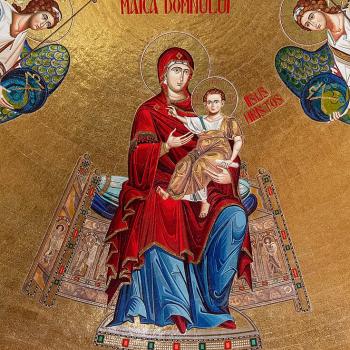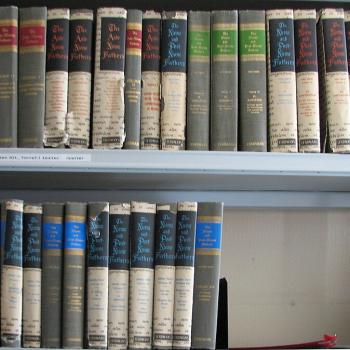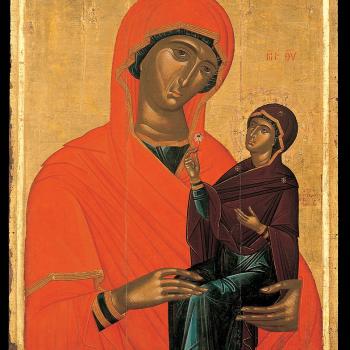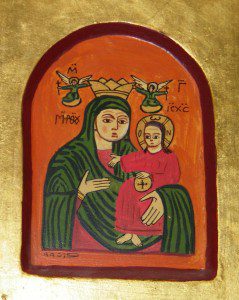
When talking about Mary, it is always important to recognize that her status, her glory, comes from her relationship with Jesus. To understand what we say about her, we will often have to examine her son, and see what it does to help us understand her. What we have said in Parts I, II, and III should solidify why it is wrong to claim that her title, Mother of God, indicates some sort of creation of God by Mary. For the title is in reference to her son, and seeks to preserve his identity as God. We will finish our discussion on why Mary is the Mother of God by briefly looking at a few more objections which sometimes are given against this teaching before moving on to other topics which concern who and what she is in salvation history.
Some suggest that instead of calling her the Mother of God she should be called the Mother of Christ. But as St. Cyril of Alexandria explained, if we call Mary the mother of mere human flesh, and use that to suggest we can call her the Mother of Christ but not God, we end up with a self-contradictory position:
They will say that because the man existed together with and is united (understood in their sense) to the Logos, it is necessary to say that He was anointed with the union. For the prophet and also the Apostle spoke of God the Logos as God and openly attributed to him the anointing. If, then, because of the union and the coexistence with the man, the saints attach to the Logos what is proper to man, they should in any case confess that this anointing took place after the union. Now, if he were anointed after the union and they do not want to speak of the union before the Virgin delivered, they should no longer call the Virgin Christotokos (Christ-bearer). For if she is Christotokos, she must also be Theotokos (God-bearer), and if she is not Theotokos, neither is she Christotokos. But if the anointing is after the union, and it is for this reason that it is mentioned in reference to the person of the Logos, and if they say that the union took place after the birth from the Virgin, then she shall no longer be found to be Christotokos. For, since the anointing cannot be conceived before the union, if the Virgin is Christotokos, because the union took place in her, she no longer gave birth to a man, as they say but to one united with the Logos, and she would justly be called Theotokos.[1]
Others want to argue against the title respond by saying that Mary is not the Mother of God, but merely the “flesh” of Jesus. The error contained in such a response is not difficult to point out: to be a mother is more than giving birth to some lump of “flesh,” but a person, and for Mary that person is Jesus, who is God. To suggest that Mary merely was a vessel in which some flesh passed through, and not even to acknowledge that the person of God the Logos was in her, undermines what it means to be a mother. Indeed, logically it leads to a rejection of motherhood not only for her, but for all mothers. For what is in a mother’s womb is not a mere lump of flesh, it is a person, and that person for Mary was Jesus, who is God. We find, therefore, that an embryo in a womb is a person who has its own personal identity (a hypostasis), and a spiritual soul which indicates a person with an intellect and will. Accidental qualities which slowly emerge in the flesh, such as bodily organs, while important for our experience of the person, emerge as the higher, spiritual nature shapes the body, and so, even when a person is in the womb is unformed in material nature, this does not mean they are not a person, because the true qualities which make them a person are there from the time of conception.[2]
Thus, we must believe that while he was in his mother’s womb, Jesus was fully human, with all the qualities associated with a human life. We don’t find in her merely a lump of flesh slowly being formed which was later taken out of Mary and then given life; the life was there from the moment of the incarnation. He was fully human once he entered her womb, and so he had all that humans have, including a human soul. We must not think there was something about being human he did not possess, even in the womb. The material organs formed while he was in the womb, yet even when they were unformed, they were there in potential, in the genetic code, and so he possessed them in his genes even before they were formed, which is the case for all persons. [3]
Yet, Jesus, who was and is fully human, remains what he is, a divine person who assumed human nature. The person is the Logos, that is, God the Son. There was no confusion of natures, no changing of Jesus’ divinity into humanity or humanity into divinity. He was and is a divine person even when he assumed our human nature, and so in the womb and out, he is God. The person who was born of Mary, Jesus, is God. He was a full person, not some partial monstrosity, when he was born. That person was Jesus, Emmanuel, God with us. That person was God. Mary, therefore, must be seen as the Mother of God, not because she is his creator but because he willingly entered her womb to be born of her. To deny this is to deny the incarnation, and the problems raised up against this teaching are the problems raised up with a poor understanding of the relationship between time and eternity, God and creation, or of what it means to be a mother.
God the Son, who is God by nature, is eternally given his divinity by being begotten by God the Father, and yet he assumed human nature in accordance to his one eternal act. God the Son made that human nature his own, so what is said and done to him in accordance to it, is said about him. His humanity, with all that comes with it, is united to him in his person; by his act of assuming humanity, he was born into the world. Even though as God he is eternal, he has a temporal birth, a birth which he assumed for himself when he took on humanity. That birth gave him, who is God, a mother, and that mother is Mary. That is all that is meant when we say Mary is the Mother of God. Certainly, as we will explore in further reflections on Mary, there are many implications which flow from the fact God chose Mary and gave her a special role in the incarnation. None of them, however, are to suggest that Mary is somehow greater than her son because she gave birth to him, nor that she created him in and through that birth. Despite being his mother, she always looked to him as his superior; she constantly gave herself over to him in one life-long fiat, making her truly the one of all of us who did the will of the Father.[4]
[1] St. Cyril of Alexandria, Against Those Who Are Unwilling to Confess That The Holy Virgin is Theotokos. trans. and ed. Protopresbyter George Dion. Dragas (Rollinsford, New Hampshire: Orthodox Research Institute, 2004), 21-3.
[2] For further analysis, exploring the question of ensoulment and why it happens at the point of conception, see St Maximos the Confessor, On Difficulties in the Church Fathers. The Ambigua. Volume II. trans. Nicholas Constas (Cambridge: Harvard University Press, 2014), 137- 73.
[3] This is also why, if someone is born without some particular organs, they are still human, because it is the material, accidental form which lacks them, but the genetic and essential character of the person continues to possess them
[4] We can become like her if we follow through and give our lives entirely over to God in the same manner, and in so doing, give birth to God the Word in our soul. This is why Jesus said, “For whoever does the will of my Father in heaven is my brother, and sister, and mother” (Matt. 12:50 RSV). It was not done, as some suggest, to disparage his mother, but rather the opposite, showing exactly how she does the will of the Father and we can become like her if we open up to him and follow him with our whole heart.
Stay in touch! Like A Little Bit of Nothing on Facebook:
A Little Bit of Nothing


